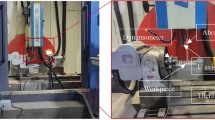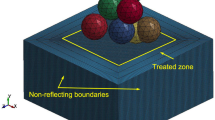Abstract
Titanium alloys with effective material characteristics are widely applied to the design of significant components of aero-engines, such as the blisk, blade, and commutator, and it is very important to create under requirement surface integrity to improve fatigue life by using advanced manufacturing technology, under the requirements of surface integrity for titanium alloy parts. In this paper, the method of micro-stiffener belt polishing (MSBP) is presented to realize anti-fatigue surface, which is based on the influence rule of the thin-plate stiffener on the bending life and the micro-crack principle. Thereafter, the surface characteristics and formation of titanium alloy MSBP are revealed by comparing analyses of the different polishing processes, using numerical simulation and advanced measuring. The belt polishing processes of reciprocating and high-speed rotation are used to form the micro-stiffener and smooth surface, respectively, while the different surface characteristics are obtained by adjusting the feeding speed and pressure. The formation rules of the surface characteristics are analyzed according to material removal under flexible contact conditions. The surface topography is expressed by the wavelet transform and polishing moving model, following which the surface topography is analyzed by means of comparison with the electron microscope test results. The workpiece surface residual stress is tested by an X-ray projector, and the distribution of different depth residual stresses is predicted by finite element analysis. The surface profile is obtained by a contour-graph, based on which the surface roughness distribution is obtained. The experimental results demonstrate that the surface characteristics, surface topography, surface roughness, and residual stress all meet the requirements. Furthermore, the micro-stiffener surface characteristics are superior to those of the smooth surface, particularly in terms of consistency. Therefore, the new method can be used to improve the surface integrity characteristics using the micro-stiffener for titanium alloy materials.
Similar content being viewed by others
References
Huang Y, Xiao GJ, Zou L (2016) Current situation and development trend of polishing technology for blisk. Acta Aeronaut Astronaut Sin 37(7):2045–2064
Volkov DI, Koryazhkin AA (2014) Adaptive belt grinding of gas-turbine blades. Russ Eng Res 34(1):37–40
Fernandez A, Dieste JA, Javierre C, Santolaria (2015) Surface roughness evolution model for finishing using an abrasive tool on a robot. Int J Adv Robot Syst 12(9):119–122
Eriksen RS, Arentoft M, Grønbæk J, Bay N (2012) Manufacture of functional surfaces through combined application of tool manufacturing processes and robot assisted polishing. CIRP Ann Manuf Technol 61(1):563–566
Jourani A, Dursapta M, Hamdia H, Recha J, Zahouani H (2005) Effect of the belt grinding on the surface texture: modeling of the contact and abrasive wear. Wear 259(7):1137–1143
Bigerelle M, Gautier A, Hagege B, Favergeon J, Bounichane B (2009) Roughness characteristic length scales of belt finished surface. J Mater Process Technol 209(20):6103–6116
Pandiyan V, Tjahjowidodo T, Samy MP (2016) In-process surface roughness estimation model for compliant abrasive belt machining process. Procedia CIRP 46:254–257
Ye XX (2013) Study on the surface integrity of titanium blade processed by CNC abrasive belt grinding. Chongqing University, Chongqing
Xiao GJ, Huang Y (2017) Adaptive belt precision grinding for the weak rigidity deformation of blisk leading and trailing edge. Adv Mech Eng 9(10):1–12
Zhao T, Shi YY, Lin XJ, Duan JH, Sun PC, Zhang J (2014) Surface roughness prediction and parameters optimization in grinding and polishing process for IBR of aero-engine. Int J Adv Manuf Technol 74(5):653–663
Axinte DA, Kritmanorot M, Axinte M, Gindy NNZ (2005) Investigations on belt polishing of heat-resistant titanium alloys. J Mater Process Technol 166(3):398–404
Axinte DA, Kwong J, Kong MC (2009) Workpiece surface integrity of Ti-6-4 heat-resistant alloy when employing different polishing methods. J Mater Process Technol 209(4):1843–1852
Zhu DH, Luo SY, Yang L, Chen W, Yan SJ, Ding H (2015) On energetic assessment of cutting mechanisms in robot-assisted belt grinding of titanium alloys. Tribol Int 90:55–59
Huo WG, Xu JH, Fu YC (2009) Grinding force and surface integrity on dry belt grinding of TA15 titanium alloys. Key Eng Mater 416:269–273
Cheng RK, Huang Y, Huang Y (2013) Experimental research on the predictive model for surface roughness of titanium alloy in abrasive belt grinding. Adv Mater Res 716:443–448
Huang Y, Xiao GJ, Zhao HQ, Zou L, Zhao L, Liu Y, Dai WT (2018) Residual stress of micro-stiffener surface with belt polishing for the titanium alloys. Procedia CIRP 71:11–15
Funding
This work was supported by National Natural Science Foundation of China (grant No. 51705047), Fundamental Research Funds for the Central Universities (2018CDQYCD0038), and Technological Innovation and Application Demonstration of Chongqing (cstc2018jszx-cyzd0092).
Author information
Authors and Affiliations
Corresponding author
Rights and permissions
About this article
Cite this article
Xiao, G., Huang, Y. Micro-stiffener surface characteristics with belt polishing processing for titanium alloys. Int J Adv Manuf Technol 100, 349–359 (2019). https://doi.org/10.1007/s00170-018-2727-x
Received:
Accepted:
Published:
Issue Date:
DOI: https://doi.org/10.1007/s00170-018-2727-x




